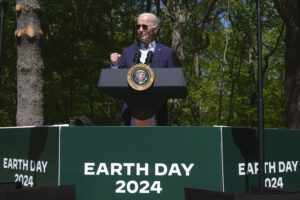Climate Change Raises Specter of Space Centre Invasion
Rising sea levels and repeated storm damage to natural coastal defenses pose an increasing threat to the famous Cape Canaveral rocket launch site in Florida. A rocket launches a TV satellite from Cape Canaveral on the Florida coast. Photo by Hendrik Scholz via Wikimedia Commons
A rocket launches a TV satellite from Cape Canaveral on the Florida coast. Photo by Hendrik Scholz via Wikimedia Commons
By Tim Radford, Climate News NetworkThis Creative Commons licensed piece first appeared at Climate News Network.
LONDON — Climate change has begun to make its mark on one of America’s most iconic sites – the Kennedy Space Centre at Cape Canaveral in Florida.
Within a decade, according to geologists, the combination punch of rising sea levels and increasing wave energy could start to affect operations at the site where, more than five decades ago, astronauts were launched towards a landing on the Moon.
Peter Adams and John Jaeger, of the University of Florida, have since 2009 been studying the dunes and the beach at Cape Canaveral that historically screened the launch site from even the worst tropical storms.
These dunes were levelled in 2008 during Tropical Storm Fay, in 2011 during Hurricane Irene, and again in 2012 during Hurricane Sandy.
Washed away
Storm waves repeatedly covered a stretch of railroad track built by the US space agency NASA during the 1960s. The line is no longer used, and part of it has been removed to make room for a protective man-made dune. NASA’s own prediction in 2010 was that the line could be permanently breached by 2016.
Hurricane Sandy, the superstorm that brought catastrophic flooding to New York and caused damage along almost all the US Atlantic seaboard, washed away a section of Cape Canaveral shoreline so close to a US Air Force launch pad that the surrounding fence was left near collapse.
“When you put immovable infrastructure right next to a dynamic environment, something has to give”
Coastal erosion is an enduring fact of life, but during the 1960s the Cape seemed a secure site for one of the great 20th-century adventures.
The two geologists, working as partners with NASA and the US Geological Survey, began looking at a problem that seemed to have been getting worse since 2004: chronic erosion of a six-mile stretch between the two launch pads used for the Apollo missions and space shuttle launches.
According to Dr Adams, the slow rise in sea levels and the increased energy of the ocean’s storm waves — both symptoms of global warming — are almost certainly to blame. He said: “Is it affecting NASA’s infrastructure? The answer’s yes.”
Although man-made dunes will protect the site for the immediate future, the space agency has already spoken of a “managed retreat”. And Dr Jaeger said: “When you put immovable infrastructure right next to a dynamic environment, something has to give.”
Evidence of flooding
As a coastal facility, Cape Canaveral is naturally vulnerable to hurricanes, which tend to lose their energy as they hit the coasts. But University of Iowa scientists report in the Bulletin of the American Meteorological Society that they have found evidence of flooding by tropical cyclones as far inland as Iowa, in the Midwest.
Gabriele Villarini, a civil and environmental engineer, found the evidence in 30 years’ worth of discharge records from more than 3,000 US Geological Survey stream measurement stations.
Between 1981 and 2011, the US was hit by more than 100 tropical cyclones or hurricanes that did their worst damage at the coast, but could also be linked with major flooding far inland.
“Our results indicate that flooding from tropical cyclones affects large areas of the US and the Midwest, as far inland as Illinois, Wisconsin and Michigan,” Villarini said.
Your support is crucial…With an uncertain future and a new administration casting doubt on press freedoms, the danger is clear: The truth is at risk.
Now is the time to give. Your tax-deductible support allows us to dig deeper, delivering fearless investigative reporting and analysis that exposes what’s really happening — without compromise.
Stand with our courageous journalists. Donate today to protect a free press, uphold democracy and unearth untold stories.






You need to be a supporter to comment.
There are currently no responses to this article.
Be the first to respond.